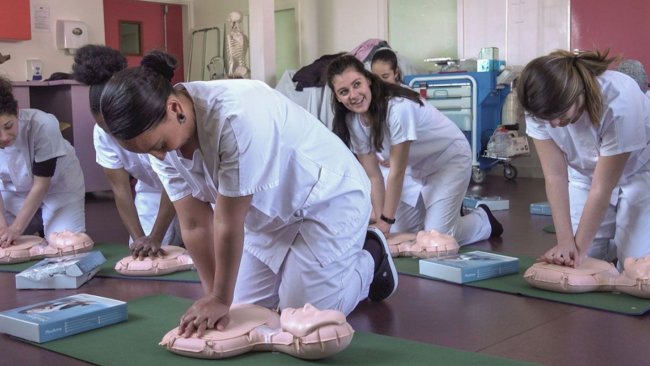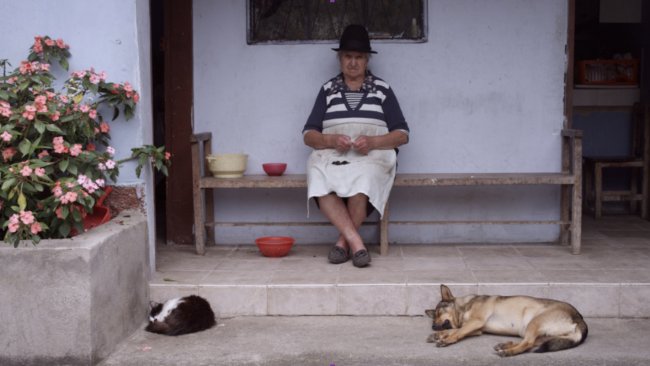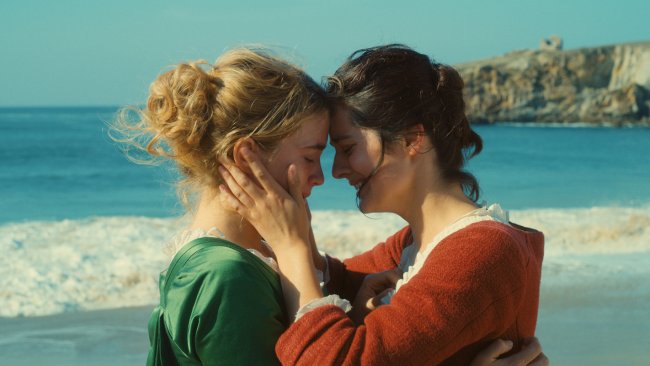El auge del humano 3
[…] S’il y a un panoptikon de la surveillance, du contrôle, «El auge del humano 3» exemplifie plutôt le panoptikon de la découverte, découverte émerveillée, où le tout voir du panoptikon (caméra 360 degrés) est seulement un point de départ pour un détournement libre vers l’inconnu.

[Two reviews: in French and English]
Whatever happened to the funky race?
A generation lost in pace
Wasn't life supposed to be more than this?
(The Ark)
Opening: El auge del humano 3, or the film as process.
El auge del humano 3 is a travelogue without borders. The tracking shots that form the backbone of Eduardo Williams’ cinema unfurl across Peru, Taiwan and Sri Lanka, as the film winds its way through a variety of terrains: coastlines, villages of post-tsunami dome houses, thick forests and mountain tops.
This kind of geographical meandering had already marked Williams’ previous offering, also titled El auge del humano (2016). Unlike the previous feature, though, here the actors travel along with the film. Defying both visa restrictions, linguistic barriers and logistics, the people we see on-screen became active participants in Williams’ process, a process that re-imagines film-making as an experience that’s both geographical and relational: a moving sideways, away from the fixed and towards the encounter (of places, of others).
There’s more. Williams experiments here with the use of a 360° camera contraption, carried up high on a rig mounted on the body of the camerawoman (except for one key sequence, when it’s just left on the ground). As a consequence, the director “framed” the film entirely in post-production, in a VR environment, tracking the movements of his own head while re-traversing the mass of filmed footage – documenting his own gaze, as it were.
Even more than the film itself, this process speaks of an aesthetic and ethical project. William’s approach is one of conscious de-centring: a stepping aside from established perspectives, frames of interpretation and even creative hierarchies. As a poetics, his practice strikes me as vital, bold, inviting us critics to reconsider what the cinema can be.
Interlude: El auge del humano 3, or the film as organism
One senses an effort (speaking roughly) to push the cinema back into reality, to re-discover its immediacy, its ability to immerse itself into the world. But this is no Bazinian fantasy: nothing essential is revealed. If anything, Williams’ dispositif is closer to a curious alien, with its all-seeing camera(s) affecting but never quite reaching the world it nevertheless inhabits. Analysis and artifice coexist. As the characters seek a seemingly impossible way out, the film turns into a relational organism: half document, half fiction, it witnesses its own coming-into-the-world. Images, it seems to suggest, belong to the fabric of lived existence just like other symbolic structures (languages, notions of property, fables) and socio-economic forces (inequality, the need to work), all of which, eventually, conspire to hold everyone in their place. That is – until one starts walking.
Conclusion: El auge del humano 3, or, the film as appendix
El auge del humano 3 moves and talks obliquely. Figures are framed marginally, as Williams’ attention is often drawn to other elements of his 360° footage. Actors talk almost constantly, but their words too are recorded from a distance, in a quasi-acousmetric fashion. As the film progresses, viewers begin to recognise their voices – but the flow of the conversation is labyrinthine, shifting frequently between the mundane and the enigmatic. Inscrutable sentences mix with seemingly spontaneous chit-chat, in an ever-growing, overlapping, multilingual tapestry.
There is some order in the midst of confusion. The film proceeds erratically, yet a rough, spiral-like structure slowly takes form. Williams achieves this by carefully orchestrating the rhythm and tone of its macro-sections, and by scattering repeated lines and motifs through the sprawling body of the film: figures randomly dropping on the ground, characters waking up, looking for a way home, etc.
It’s hard to say whether it all works, aesthetically. The formal beats are slow to arrive: at times, viewers are left to wonder whether there’s any structure at all, and there’s undeniably a hint of complacency in the way the film manifests itself as both impenetrable and rough around the edges. But again, perhaps here the process is more important than the outcome. As one of the characters in the film cheekily point out, «things that are beautiful are dangerous».
PM Cicchetti
*
Sigue adelante, continue, continue d’aller, keep going : voilà la devise immanente qui hante le dernier film d’Eduardo Williams. Non seulement les protagonistes d’El auge del humano 3 ne cessent de marcher, mais c’est la caméra de Williams qui marche elle aussi presque constamment. Et nous avec elle, car il s’agit d’un mouvement de caméra à vitesse humaine. Avec elle nous suivons une ligne qui traverse le Pérou, le Sri Lanka et Taïwan, une ligne parfaitement continue grâce à la complicité « réalisticonirique » de cette pénombre qui caractérisait déjà les précédents projets filmiques du réalisateur argentin, une pénombre qui réalise le rêve éveillé (daydreaming) en tant que présence sensorielle.
En réalité, il s’agit d’une caméra dans la caméra : Williams filme à l’intérieur d’une première version montée de son film ou bien, plus précisément, c’est dans un headset qu’il enregistre sa propre exploration des images précédemment tournées avec une caméra 360 degrés. Ce que nous voyons, donc, c’est l’exploration d’un territoire global, entre l’Amérique et l’Asie, mais aussi l’exploration de la globalité à laquelle la nouvelle technologie de filmage nous donne accès – la géographie globale était anticipée par le précédent El auge del humano (2016), et le dispositif technologique était quant à lui anticipé par l’expérience de Parsi (avec Mariano Blatt, 2018). Si le cinéma a toujours été habité par le désir de voir plus, de voir mieux – et non pas seulement de représenter – le film de Williams incarne ce désir au mieux. Il ne s’agit pas de tout voir (dans une scène centrale, presque didactique, l’abîme d’abstraction que ce que tout voir impliquerait nous surprendra), mais d’assumer la disponibilité à tout voir que la technologie nous offre pour mettre en scène le voir lui-même, l’acte exploratif de la vision, dans son état apparemment spontané – où hallucination et observation se confondent. S’il y a un panoptikon de la surveillance, du contrôle, El auge del humano 3 exemplifie plutôt le panoptikon de la découverte, découverte émerveillée, où le tout voir du panoptikon (caméra 360 degrés) est seulement un point de départ pour un détournement libre vers l’inconnu.
Cela dit, le mouvement au rythme de la marche humaine et la vision comme acte exploratif constituent deux éléments d’un langage de cinéma qui est également, et littéralement, porté par un troisième élément fondamental : la relation humaine, où amitié et complicité priment sur tout conflit potentiel. Des jeunes tombent soudainement victimes de narcolepsie ou volent plus haut que les sommets des montagnes, mais surtout ils se cherchent, se croisent, marchent ensemble : El auge del humano 3 tisse le récit sans histoire d’un groupe d’ami.es à l’harmonie polyglotte, et sans polarité de genre – figures d’un Eden paisibles et inquiet. Fraternité ou sororité animent des dialogues presque toujours loin du point de vue de la caméra, et qui se tiennent également souvent loin de notre compréhension. Au parlé du quotidien se superpose un texte aux ellipses énigmatiques, que j’aime bien lire en tant que re-écriture poétique d’un small talk qui côtoie petitesse et vertige à la fois. Il ne s’agit pas de com-prendre, de tout prendre, mais de se pencher sur le vide, sur l’invisible.
L’expérience – et l’expérience dont le cinéma en particulier est capable – est crampe et plaisir à la fois ; rarement un film en exprime la fusion comme celui-là. Mais il s’agit aussi d’une fusion d’agitation et de calme qui sont propres à toute exploration, où la marche reste ouverte à la rencontre de l’inattendu.
Giuseppe Di Salvatore
Watch
Screenings at Visions du Réel Nyon 2024
Info
El auge del humano 3 | Film | Eduardo Williams | ARG-PT-NL-BRA-TWN-LKA-HGK-PER 2023 | 121’ | Locarno Film Festival 2023, Visions du Réel Nyon 2024
First published: August 13, 2023



